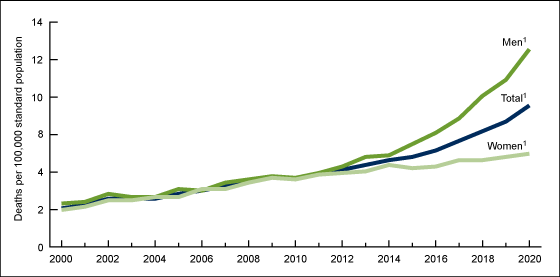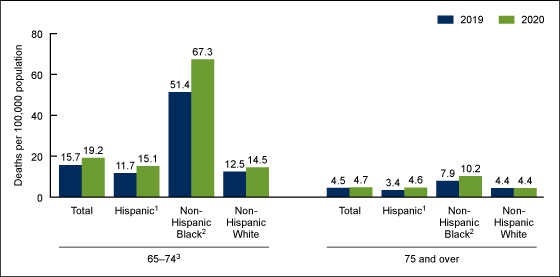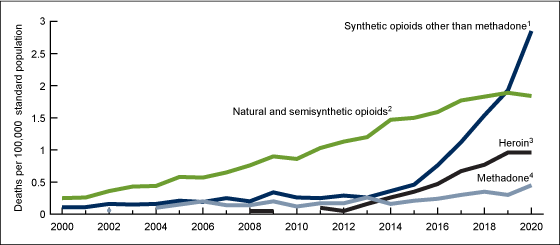Drug Overdose Deaths in Adults Aged 65 and Over: United States, 2000–2020
NCHS Data Brief No. 455, November 2022
PDF Version (417 KB)
- Key findings
- Rates of drug overdose deaths for adults aged 65 and over increased from 2000 through 2020.
- In both 2019 and 2020, non-Hispanic Black men aged 65 and over had higher drug overdose death rates than non-Hispanic White and Hispanic men.
- In both 2019 and 2020, non-Hispanic Black women aged 65–74 had the highest drug overdose death rates, while for women aged 75 and over, death rates were highest for non-Hispanic White women.
- In 2020, rates of drug overdose deaths involving opioids for adults aged 65 and over were highest for deaths involving synthetic opioids other than methadone.
- Summary
Data from the National Vital Statistics System
- Between 2000 and 2020, age-adjusted rates of drug overdose deaths for adults aged 65 and over increased from 2.4 to 8.8 deaths per 100,000 standard population.
- For men aged 65–74 and 75 and over, rates of drug overdose deaths were higher among non-Hispanic Black men compared with Hispanic and non-Hispanic White men.
- For women aged 65–74, drug overdose death rates were higher for non-Hispanic Black women compared with Hispanic and non-Hispanic White women, but for women aged 75 and over, non-Hispanic White women had the highest rates.
- The age-adjusted rate of drug overdose deaths involving synthetic opioids other than methadone (such as fentanyl) for adults aged 65 and over increased by 53% between 2019 (1.9) and 2020 (2.9).
In 2020, 5,209 drug overdose deaths in adults aged 65 and over were recorded (1). Drug overdose death rates for older adults were lower than for other age groups but have increased in the past 2 decades (1,2). This report presents age-adjusted trends in drug overdose death rates, including trends in the type of opioid drug involved, for adults aged 65 and over for 2000–2020 using mortality data from the National Vital Statistics System (NVSS). Age- and sex-specific death rates for adults aged 65–74 and 75 and over are shown by race and Hispanic origin for 2019 and 2020.
Keywords: older adults, race and Hispanic origin, drug poisoning, opioids, National Vital Statistics System
Rates of drug overdose deaths for adults aged 65 and over increased from 2000 through 2020.
- Between 2000 and 2020, age-adjusted rates of drug overdose deaths for adults aged 65 and over increased from 2.4 deaths per 100,000 standard population to 8.8 (Figure 1).
- For men, after increasing by 5% annually on average between 2000 (2.7) and 2014 (5.7), drug overdose death rates increased by 14% annually on average and more than doubled between 2014 and 2020 (12.3).
- For women, drug overdose death rates nearly doubled between 2000 (2.3) and 2009 (4.3) and continued to increase at a slower rate from 2009 to 2020 (5.8).
- Age-adjusted rates of drug overdose deaths for men were 1.2 times higher than for women in 2000 and 2.1 times higher in 2020.
Figure 1. Age-adjusted drug overdose death rate for adults aged 65 and over, by sex: United States, 2000–2020

1Significant increasing trend from 2000 through 2020 with different rates of change over time; p < 0.05.
NOTES: Drug overdose deaths are identified using the International Classification of Diseases, 10th Revision underlying cause-of-death codes X40–X44, X60–X64, X85, and Y10–Y14. Access data table for Figure 1.
SOURCE: National Center for Health Statistics, National Vital Statistics System, Mortality.
In both 2019 and 2020, non-Hispanic Black men aged 65 and over had higher drug overdose death rates than non-Hispanic White and Hispanic men.
- For men aged 65–74, drug overdose death rates increased from 2019 to 2020 for all men, as well as for Hispanic (from 11.7 to 15.1 deaths per 100,000 population), non-Hispanic Black (from 51.4 to 67.3), and non-Hispanic White (from 12.5 to 14.5) men. However, death rates did not increase significantly from 2019 to 2020 for men aged 75 and over (Figure 2).
- In 2020, drug overdose death rates for men aged 65–74 were higher for non-Hispanic Black men (67.3) compared with Hispanic (15.1) and non-Hispanic White (14.5) men.
- For men aged 75 and over in 2020, drug overdose death rates were higher for non-Hispanic Black men (10.2) compared with Hispanic (4.6) and non-Hispanic White (4.4) men.
Figure 2. Drug overdose death rate for men aged 65 and over, by age group, race and Hispanic origin, and year: United States, 2019–2020

1Rates were significantly lower than rates for non-Hispanic Black men in 2019 and 2020; p < 0.05.
2Rates were significantly higher than rates for non-Hispanic White men in 2019 and 2020; p < 0.05.
3Rates for 2020 were significantly higher than 2019 for all groups; p < 0.05.
NOTES: Total includes races and origins not shown separately. Data for categories other than non-Hispanic White and non-Hispanic Black should be interpreted with caution because of inconsistencies in reporting race and ethnicity on death certificates, censuses, and surveys. Drug overdose deaths are identified using the International Classification of Diseases, 10th Revision underlying cause-of-death codes X40–X44, X60–X64, X85, and Y10–Y14. Access data table for Figure 2.
SOURCE: National Center for Health Statistics, National Vital Statistics System, Mortality.
In both 2019 and 2020, non-Hispanic Black women aged 65–74 had the highest drug overdose death rates, while for women aged 75 and over, death rates were highest for non-Hispanic White women.
- From 2019 to 2020, drug overdose death rates for women aged 65–74 increased for non-Hispanic Black women from 9.9 to 12.0 deaths per 100,000 population; however, death rates for the other race and Hispanic-origin groups did not change significantly (Figure 3).
- In 2020, drug overdose death rates for women aged 65–74 were higher for non-Hispanic Black women (12.0) compared with Hispanic (3.4) and non-Hispanic White (8.3) women.
- In 2020, drug overdose death rates for women aged 75 and over did not change significantly compared with rates in 2019, and were higher for non-Hispanic White women (3.8) compared with Hispanic (2.4) and non-Hispanic Black (2.0) women.
Figure 3. Drug overdose death rate for women aged 65 and over, by age group, race and Hispanic origin, and year: United States, 2019–2020

*Rate does not meet National Center for Health Statistics standards of reliability.
1Rate for 2020 was significantly higher than 2019; p < 0.05.
2Rates were significantly lower than rates for non-Hispanic Black and non-Hispanic White women for 2019 and 2020; p < 0.05.
3Rates were significantly higher than rates for non-Hispanic White women for 2019 and 2020; p < 0.05.
4Rate was significantly lower than rate for non-Hispanic White women for 2020; p < 0.05.
5Rates were significantly lower than rates for non-Hispanic White women for 2019 and 2020; p < 0.05.
NOTES: Total includes races and origins not shown separately. Data for categories other than non-Hispanic White and non-Hispanic Black should be interpreted with caution because of inconsistencies in reporting race and ethnicity on death certificates, censuses, and surveys. Drug overdose deaths are identified using the International Classification of Diseases, 10th Revision underlying cause-of-death codes X40–X44, X60–X64, X85, and Y10–Y14. Access data table for Figure 3.
SOURCE: National Center for Health Statistics, National Vital Statistics System, Mortality.
In 2020, rates of drug overdose deaths involving opioids for adults aged 65 and over were highest for deaths involving synthetic opioids other than methadone.
- For adults aged 65 and over, age-adjusted rates of drug overdose deaths involving synthetic opioids other than methadone (such as fentanyl, fentanyl analogs, and tramadol) increased throughout the period, with higher rates of increase from 2013 through 2020. From 2019 to 2020, the death rate increased by 53%, from 1.9 deaths per 100,000 standard population to 2.9 (Figure 4).
- Age-adjusted rates of drug overdose deaths involving natural and semisynthetic opioids (such as codeine, oxycodone, and hydrocodone) increased from 2000 to 2017 and did not change significantly from 2017 through 2020.
- For adults aged 65 and over, age-adjusted rates of drug overdose deaths involving heroin increased from 2011 to 2017 and then did not change significantly from 2017 to 2020.
- The age-adjusted rates of drug overdose deaths involving methadone for adults aged 65 and over increased from 2004 (0.1) through 2020 (0.5).
Figure 4. Age-adjusted rate of drug overdose deaths involving opioids for adults aged 65 and over, by type of opioid: United States, 2000–2020

1Significant increasing trend from 2000 through 2020, with different rates of change over time; p < 0.05.
2Significant increasing trend from 2000 through 2017, with different rates of change over time, and stable trend from 2017 through 2020; p < 0.05.
3Significant increasing trend from 2011 through 2017, and stable trend from 2017 through 2020; p < 0.05.
4Significant increasing trend from 2004 through 2020; p < 0.05.
NOTES: Drug overdose deaths are identified using the International Classification of Diseases, 10th Revision underlying cause-of-death codes X40–X44, X60–X64, X85, and Y10–Y14. Drug overdose deaths involving opioids are identified by specific multiple-cause-of-death codes: heroin, T40.1; natural and semisynthetic opioids, T40.2; methadone, T40.3; and synthetic opioids other than methadone, T40.4. Deaths involving more than one opioid category are counted in both categories. Data are missing for years in which the number of deaths does not meet National Center for Health Statistics standards of reliability. Access data table for Figure 4.
SOURCE: National Center for Health Statistics, National Vital Statistics System, Mortality.
Summary
Drug overdoses are the underlying cause of a small proportion (0.2%) of total deaths among adults aged 65 and over (5,209 of 2,509,396 deaths in 2020), and drug overdose death rates for this age group have increased in the past 2 decades (1,2). Between 2000 and 2020, age-adjusted death rates for adults aged 65 and over increased from 2.7 deaths per 100,000 standard population to 12.3 for men and from 2.3 to 5.8 for women. For men aged 65–74 in 2020, death rates were highest for non-Hispanic Black men (67.3) compared with non-Hispanic White (14.5) and Hispanic (15.1) men. Drug overdose death rates for women aged 65–74 were lower than rates for men, but non-Hispanic Black women (12.0) also had higher rates compared with non-Hispanic White (8.3) and Hispanic (3.4) women. The rate of drug overdose deaths involving synthetic opioids other than methadone (such as fentanyl, fentanyl analogs, and tramadol) increased by 53% from 2019 to 2020 among adults aged 65 and over.
High death rates of drug overdose among working-age adults have been widely documented (2–5). Recently, increasing drug overdose death rates among older adults have also been noted and large racial disparities have been identified, especially among men (6,7). This report describes sex, age, and race and Hispanic-origin differences in drug overdose death rates within the age 65 and over population and demonstrates subgroup disparities.
Definitions
Drug poisoning (overdose) deaths: Includes deaths resulting from unintentional or intentional overdose of a drug, being given the wrong drug, taking a drug in error, or taking a drug inadvertently.
Natural and semisynthetic opioids: Includes such drugs as morphine, codeine, hydrocodone, and oxycodone.
Synthetic opioids other than methadone: Includes such drugs as fentanyl, fentanyl analogs, and tramadol.
Data source and methods
Estimates in this report are based on the NVSS multiple-cause-of-death files, accessed using the CDC WONDER online database (1). Drug overdose deaths are defined as having an International Classification of Diseases, 10th Revision (ICD–10) underlying cause-of-death code of X40–X44 (unintentional), X60–X64 (suicide), X85 (homicide), and Y10–Y14 (undetermined intent). The type of drugs involved are indicated by ICD–10 multiple-cause-of-death codes: heroin, T40.1; natural and semisynthetic opioids, T40.2; methadone, T40.3; and synthetic opioids other than methadone, T40.4 (8).
Age-adjusted death rates are calculated using the direct method and adjusted to the 2000 U.S. standard population. Age-adjusted death rates are useful when comparing different populations because they remove the potential bias that can occur when the populations being compared have different age structures (9). Trends in death rates were evaluated using the Joinpoint Regression Program (Version 4.8.1.0) (10). Joinpoint software fitted weighted least-squares regression models to the rates on the log transform scale. Analyses were set to allow a maximum of three joinpoints across the period, a minimum of three observed time points from any given joinpoint to either end of the data, and a minimum of four observed time points between any two joinpoints. The permutation tests for model (number of joinpoints) significance were set at an overall alpha level of 0.05 (11). Pairwise comparisons of rates (for example, age-adjusted rates for males compared with females) were conducted using a z test with an alpha level of 0.05 (12).
Race and Hispanic origin are categorized based on the Office of Management and Budget 1997 standards for federal statistical and administrative reporting (13). All of the race categories are “single race,” meaning that only one race was reported on the death certificate. Data shown for the Hispanic population include people of any race. Death rates for Hispanic people may be affected by misclassification of race and Hispanic origin on death certificates. This misclassification could result in underreporting of deaths for this group by about 3% (14).
About the authors
Ellen A. Kramarow is with the National Center for Health Statistics (NCHS) Division of Analysis and Epidemiology, and Betzaida Tejada-Vera is with the NCHS Division of Vital Statistics.
References
- Centers for Disease Control and Prevention. CDC WONDER online database. Single-race population estimates, 2018–2020.
- Hedegaard H, Miniño AM, Warner M. Drug overdose deaths in the United States, 1999–2019. NCHS Data Brief, no 394. Hyattsville, MD: National Center for Health Statistics. 2020.
- Case A, Deaton A. Rising morbidity and mortality in midlife among white non-Hispanic Americans in the 21st century. Proc Natl Acad Sci U S A 112(49):15078–83. 2015.
- National Academies of Sciences, Engineering, and Medicine. High and rising mortality rates among working-age adults. Washington, DC: The National Academies Press. 2021.
- Hedegaard H, Miniño AM, Spencer MR, Warner M. Drug overdose deaths in the United States, 1999–2020. NCHS Data Brief, no 428. Hyattsville, MD: National Center for Health Statistics. 2021.
- Mason M, Soliman R, Kim HS, Post LA. Disparities by sex and race and ethnicity in death rates due to opioid overdose among adults 55 years or older, 1999 to 2019. JAMA Netw Open 5(1):e2142982. 2022.
- Kariisa M, Davis NL, Kumar S, Seth P, Mattson CL, Chowdhury F, Jones CM. Vital signs: Drug overdose deaths, by selected sociodemographic and social determinants of health characteristics—25 states and the District of Columbia, 2019–2020. MMWR Morb Mortal Wkly Rep 71(29):940–7. 2022.
- World Health Organization. International statistical classification of diseases and related health problems, 10th revision (ICD–10). 5th ed. 2016.
- Anderson RN, Rosenberg HM. Age standardization of death rates: Implementation of the year 2000 standard. National Vital Statistics Reports; vol 47 no 3. Hyattsville, MD: National Center for Health Statistics. 1998.
- National Cancer Institute. Joinpoint Regression Program (Version 4.8.0.1) [computer software]. 2021.
- Ingram DD, Malec DJ, Makuc DM, Kruszon-Moran D, Gindi RM, Albert M, et al. National Center for Health Statistics guidelines for analysis of trends. National Center for Health Statistics. Vital Health Stat 2(179). 2018.
- Xu JQ, Murphy SL, Kochanek KD, Arias E. Deaths: Final data for 2019. National Vital Statistics Reports; vol 70 no 8. Hyattsville, MD: National Center for Health Statistics. 2021.
- Office of Management and Budget. Revisions to the standards for the classification of federal data on race and ethnicity. Fed Regist 62(210):58782–90. 1997.
- Arias E, Heron M, Hakes JK. The validity of race and Hispanic-origin reporting on death certificates in the United States: An update. National Center for Health Statistics. Vital Health Stat 2(172). 2016.
Suggested citation
Kramarow EA, Tejada-Vera B. Drug overdose deaths in adults aged 65 and over: United States, 2000–2020. NCHS Data Brief, no 455. Hyattsville, MD: National Center for Health Statistics. 2022. DOI: https://dx.doi.org/10.15620/cdc:121828.
Copyright information
All material appearing in this report is in the public domain and may be reproduced or copied without permission; citation as to source, however, is appreciated.
National Center for Health Statistics
Brian C. Moyer, Ph.D., Director
Amy M. Branum, Ph.D., Associate Director for Science
Division of Analysis and Epidemiology
Irma E. Arispe, Ph.D., Director
Kevin C. Heslin, Ph.D., Associate Director for Science
Division of Vital Statistics
Steven Schwartz, Ph.D., Director
Andrés A. Berruti, Ph.D., M.A., Associate Director for Science